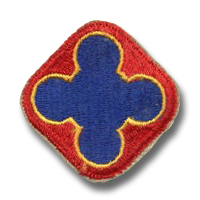If you do NOT see the Table of Contents frame to the left of this page, then
Click here to open 'USArmyGermany' frameset |
350th Infantry Regiment
USFA Tactical Command
Looking for more information from military/civilian personnel assigned to or associated with the U.S. Forces, Austria from 1945 to 1955. If you have any stories or thoughts on the subject, please contact me . . |
|
|
|
|
|
| |
| Regimental
History |
|
| 1948-52 |
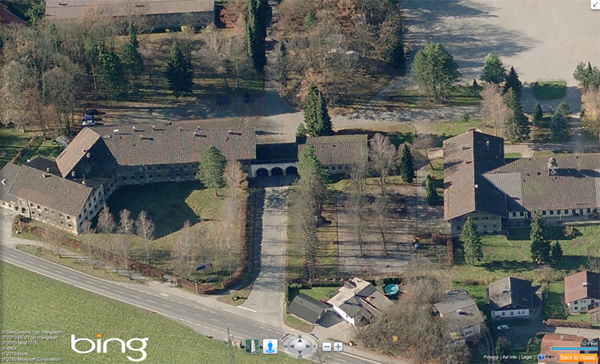
Access road to former Camp Truscott, Glasenbach (Bing Maps) |
|
|
Check out the Bing Maps site to view (aerial or bird's eye view) the entire former Camp Truscott (redesignated as Rainerkaserne by the Austrian Army after 1955) from various angles. Very nice! |
|
|
|
| 1952 |
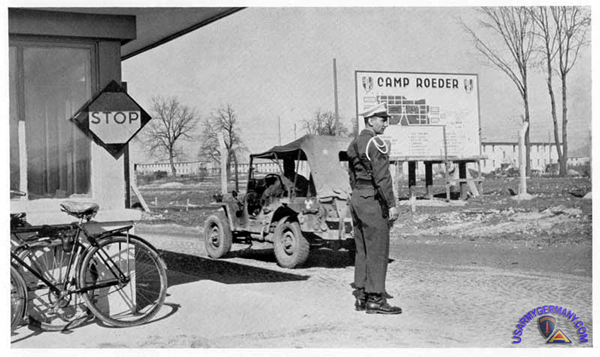
Camp Roeder main gate, Salzburg, 1952 |
| |
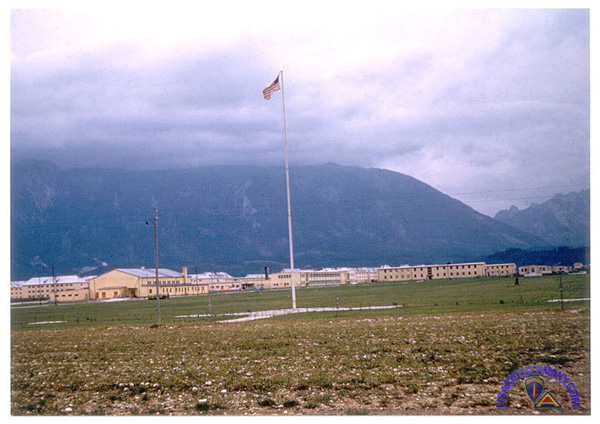
Camp Roeder, Salzburg, 1955 |
|
| |
(Source: Pictorial Review "350th Infantry, Austria 1952-1953") |
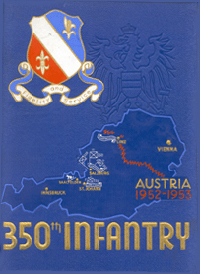 |
|
The 350th Infantry Regiment was first activated at Camp Dodge, Iowa on September 4 1917, as part of the 88th Infantry Division. The majority of its members at that time came from North and South Dakota, Minnesota, Iowa, and Illinois. One year later the Regiment landed in France for its first overseas duty, taking part in World War I.
As a part of the 88th Infantry Division, the Regiment rounded out its training in the Côte d'Or region of France with the 7th French Army prior to going into combat. On October 12 1918 the 350th moved up to the front lines, occupying positions in the haute-Alsace area of France.
The Regiment distinguished itself in several operations near the key city of Mulhouse, in that sector of France. During this period, members of the 350th Infantry were the first of the 88th Division to receive the French Croix de Guerre, awarded for heroic achievement. |
|
|
Immediately after the Armistice in 1918 the 88th Division's four-leaf-clover insignia was adopted. This emblem, worn by members of the 350th Infantry, was designed by forming two figure eights to form a four-leaf clover, for good luck, and was colored blue for the Infantry. By the time the Division was deactivated on May 9 1919 the 88th Division was generally known as the Clover-Leaf Division.
When the United States entered World War II the 350th was again activated as a component of its old parent unti, the 88th, the reactivation took place at Camp Gruber, Oklahoma on July 15 1942. The Division was triangulated at this time, and consisted of the 349th, 350th and 351st Infantry Regiments.
On this occasion the major part of its personnel came from New England, New Jersey, and New York, and the cadre from Fort Bragg's 9th Infantry Division. Training began on August 1 1942. After completion of training in the United States and North Africa, the Division was moved to Italy in January 1944, ready for combat. The 88th Infantry Division was the first organized Reserve Division to go overseas, and also the first to enter combat.
Committed to action on the main Fifth Army front north of Naples on March 4 1944, in what was later known as the Rome-Arno Campaign, the Regiment played an active part in the liberation of Rome. On June 5 1944 the 350th Infantry was the first Allied unit to enter the Italian capital.
Spearheading the entire Fifth Army drive north from Florence towards the Po Valley in the autumn of 1944, the 350th Infantry progressed step by step until the unit captured a strategic high point of resistance that was to become famous in the annals of history. The place was Mount Battaglia - in English, "Battle Mountain".
After consolidating positions on Mount Battaglia, the Regiment repelled attack after attack by strong German forces for seven straight days. A full fifty percent of the Regiment became casualties in this action, with every company commander except one either killed or wounded. For their achievement in holding this mountain at such bitter cost the Second Battalion received the Presidential Unit Citation.
After this fierce mountain action the Regiment was nicknamed the Battle Mountain Regiment. It was "Axis Sally" herself, in her infamous broadcasts from Berlin during the war, who gave the 88th Infantry Division the nickname "Blue Devils" by which the Division is still known today.
In the great spring offensive of 1945 the Regiment assisted in the capture of key points of the German lines in the northern Appenine mountains, corssed the Po Valley, and attacked to capture the key city of Vicenza. The Regiment then turned north into the Alps, heading for the Brenner Pass with other elements of the Division towards a link-up with the 7th Army forces then moving southward through Austria. Deep in the Italian Alps the Regiment received word that the war in Italy had ended on May 2 1945.
The record shows that the 350th Infantry during the time it was in combat - March 4 1944 to May 2 1945 - suffered over four thousand battale casualties, of whom twelve hundred were killed in action.
After the cessation of hostilities the 350th Infantry started the job of rounding up the remanants of the German Army in Northern Italy. When this task was completed the Regiment, along with the rest of the 88th Division, was assigned the delicate job of occupying the Morgan Line in the Venezia-Gulia Province of Italy, facing east towards Yugoslavia. This area of agitation was the focal point in the Italian-Yugoslav border controversies of the first years after the war.
The 350th Infantry was deactivated late in 1947, but was again activated on June 15 1948 at Camp Truscott, in Austria, to replace the 16th Infantry Regiment in occupying the United States Zone of Austria and the United States Sector of Vienna.
When it was reactivated in 1) 1948 the Regiment was stationed at Battalion-sized posts. Originally the 1st Battalion was in Vienna, while the Headquarters, Service, Medium Tank, Medical, and Heavy Motor Companies, as well as the 2nd Battalion, were at Camp McCauley, near Linz. In January 1949 the 1st Battalion was transferred to Camp Saalfelden with the Heavy Motor and Medium Tank Companies; the 2nd Battalion was transferred to Camp St. Johann; and the Headquarters, Service, and Medical Companies were transferred to Camp Truscott, where the 3rd Battalion was reactivated.
In March of 1951 the Regiment was assigned to USFA Tactical Command, and is now a divisional-type Regiment rather than a separate Regiment.
Consolidation of the 350th Infantry Regiment forces was accomplished in April 1952, when all units of the Regiment, except for the 2nd Battalion, completed the move to Camp Roeder, near Salzburg.
1) The 350th Infantry Regiment was reactivated at Camp Truscott, Salzburg, on June 16, 1948, when Lt Gen Geoffrey Keyes, U.S. high commissioner to Austria, presented the colors to Col Peter P. Salgado, regimental commander (STARS & STRIPES Feb 5, 1949). |
|
|
|
| 1953 |
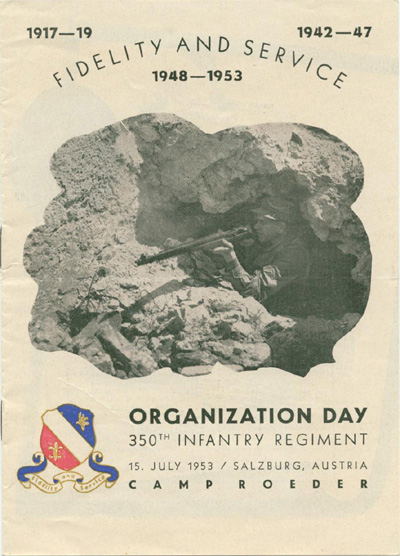
Organization Day pamphlet, 1953
|
|
| |
| 1955 |
| (Source: Email from Dave Scott) |
I was a "Johnny come lately" arriving at Camp Roeder in May 1955.
I was assigned to E Co.
By then the 2nd Bn had moved to Camp Roeder.
I was fresh out of OCS, FT. Benning but our stay in Austria was short lived. The Austrian peace treaty had been signed and by the fall all units were preparing to leave.
Short timers were transfered to 3rd Bn and it went back to the States. The 1st Bn. went to Vicenza, Italy.
Regimental HQ, separate companies and the 2nd Bn went to Mannheim, Germany.
Within the naxt year the Regiment was deactivated and the 2nd Bn. became 58th Armd. Inf. Bn. and assigned to SETAF.
I lost contact when I shipped back home in March 1957. |
 |
|
| |
| 1st Battalion |
|
| 1952 |
| (Source: Pictorial Review "350th Infantry , Austria 1952-1953") |
The 1st Battalion was reactivated in Vienna, Austria, in 1946 to assume guard of the International Zone and to represent the United States Government in the International City. In 1947 the Battalion moved to Camp McCauley. Austria, and later to Camp Saalfelden, Austria. During the stay at Saalfelden, the 1st Battalion trained in the mountain area, and soon developed into a hardened, well-trained maountain battalion. The summer of 1951 found the Battalion moving to its present station at Camp Roeder, Austria.
Highlights of achievement in the field are reflected in the fine record established during the "British Exercise of 1948"; Exercise "Rainbow" with the 1st Infantry Division during 1950; Exercise "Snowshoe" in 1951, in Upper Land Austria; and the famous Exercise "Frosty", in the Mondsee area during the winter of 1952. |
|
|
| |
| 1956 (SETAF) |
| (Source: Email from Frank Krus, Hq Co, 1st Battalion) |
The arrival was duly noted by the Communist daily "L' [or La] Unitá." It described the "discheveled and unshaven Americans" who entered their city after alighting from the special train which brought us from Salzburg. Referenace was made to WWII GI's entering the city. In fairness, I guess we were pretty grubby after a day on the rails. [Not 1st class as you might well imagine.]
I recall the prices in town doubled or tripled by the time it came for me to return to the US in Sep 1956. Training was cobbled together for the year I was there. The post started with two flush toilets. Being in the commo platoon of Hq Co, we quickly found and used one until the barracks were so equipped. The users were sworn to secrecy which was never broken, as the room was down the hall from the Bn Cmdr's office, Col Hawke. I cannot recall his first name but from my vantage point [E-4] he was well liked by all.
There was some field training at Asiago, and I well remember communicating by radio with an L-5 light aircraft, while looking down at it, while traversing the 11 hairpin turns to get to the area. My buddy drove the ammo truck which meant 11 turns requiring him to back the 2 1/2 to the edge of the road, in order to complete each turn. For some reason he would not be in the beer hall with us the night before the trip to Asiago. [I still enjoy the mountains whenever I find myself in those surroundings.]
We stood a formal retreat at least once a week along with Italian troops, in order to retire the colors of both countries. This meant learning each other's commands. I was in the minority in that I enjoyed the pomp and ceremony. Maybe that explains the fact I retired with almost 37 yrs of service. My first 3 primarily with USFA and then 11 yrs USAR [12th SF Grp], beginning in 1966, and then 18 in the Illinois Air National Guard, in the 217th EI Squadron. [Communications-retired E-8 in 95]. I know my USFA platoon sergeant [Bernie Smith] is probably rolling in his grave at the thought. Looking back I would have felt the same if I were in his shoes, but we all grow up, given plenty of time.
During warm weather we usually found our way to Venice for the week-end. Tough duty. During my trip back there last fall I was confused at first by the relocation of the main gate from the front of the post, to what I call the rear, where an Italian Interstate seems to have grown. I got my bearings when I spotted the mess hall, which is still in the same place. The two primary units now there are the recently reactivated 173rd Abn Bigade, and part of the 508th Abn. The young soldiers I saw were a credit to our country. I also saw some warrants that I think I might still be able to at least keep up with. Enough for now, and if you need some more details on this message, I'll be happy to do the best I can.
I have noticed that we do not have too many from 1st Bn, from 1955-56.
|
|
 |
|
| |
| 2nd Battalion |
|
| 1955 |
| (Source: Email from Jack Kokoletsos |
Jack Kokoletsos served in Co H, 2nd Bn 350th from March 1955 thru Sept 1956 (The Bn relocated to Mannheim in Sept 1955).
After the Austrian Peace Treaty was signed by the four powers, the 350th composed only of the 2nd Bn - now at full strength - was transferred by troop train to Mannheim, Germany, on Sept 1, 1955 to await completion of a base in Leghorn, (Livorno) Italy. The unit was assigned to the new SETAF command in Italy. (This command is still in existence and currently stationed at Caserma Ederle in Vicenza, Italy.) |
|
Co H, 2nd Bn
Camp Roeder, Salzburg |
|
|
|
|
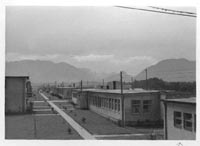
1. Company mess hall buildings
|
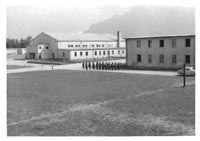
2. Company G drills for Change-over ceremony in Vienna
|
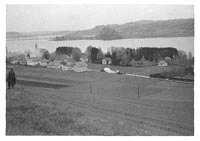
3. Co H during maneuvers during manuevers on May 3, 1955 near Salzburg
|
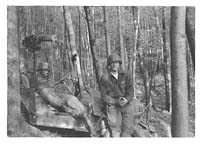
4. Jack Kokoletsos and another member of Co H during maneuvers |
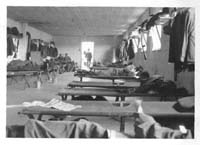
5. Troop billets at Grafenwoehr
|
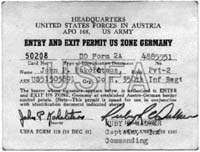
6. Entry & Exit Permit
|
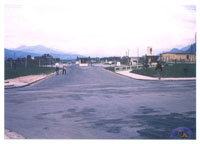
7. Main Gate, 1955
|
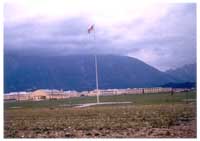
8. Parade Ground, 1955 |
|
|
|
|
| |
Co H, 2nd Bn
Taylor Bks , Mannheim |
|
|
|
|
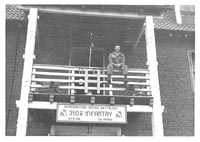
1. HQ Bldg, 2nd Bn, 350th Inf
|
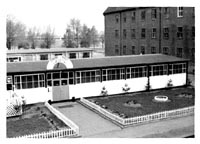
2. Unit mess hall at Taylor Barracks
|
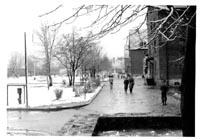
3. Winter scene at Taylor Barracks
|
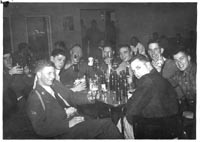 4. Co H doing some drinking at the EM Club, Taylor Barracks, Mannheim 4. Co H doing some drinking at the EM Club, Taylor Barracks, Mannheim |
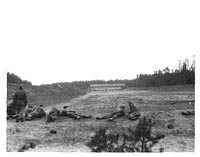
5. Firing range at Lampertheim, Germany, Dec 3-9, 1955
|
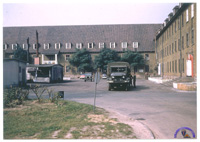
6. Co H billets on Taylor Bks, Mannheim, Fall 1955
|
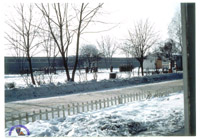
7. Co H officer is awarded Silver Star for Korean War service, 1956
|
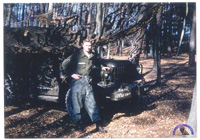 4. 8. James (Jim) Addicott, a good buddy and a great soldier, in Germany, Fall 1955 4. 8. James (Jim) Addicott, a good buddy and a great soldier, in Germany, Fall 1955 |
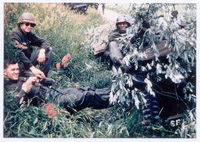
9. Several members of the 350th Inf Regt in "alert" positions (126 KB)
|
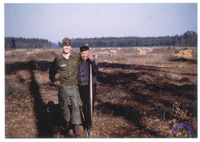
10. Jack Kokoletsos and a German farmer (126 KB)
|
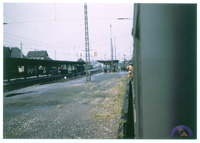
11. Troop train halts in Stuttgart (126 KB)
|
|
|
|
|
|
Miscellaneous
Salzburg & Rest Centers |
|
|
|
|
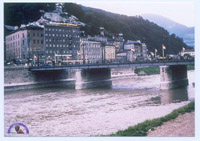
1. Flag-adorned bridge (Staatsbrücke) scene at Salzburg (109 KB)
|
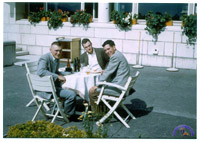
2. Several members of Co H enjoy a meal outdoors at the General Walker Hotel (91 KB)
|
|
|
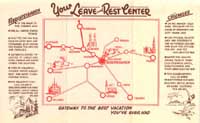
3. Berchtesgaden & Chiemsee Brochure (62 KB)
|
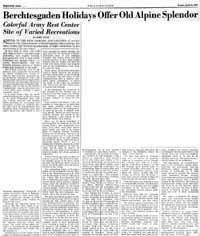
4. SACOM Scene article on Berchtesgaden Leave and Rest Center - includes photos (436 KB)
|
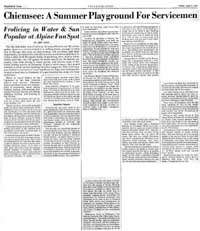
5. SACOM Scene article on Chiemsee Leave and Rest Center - includes photos (528 KB) |
|
|
 |
|
| |
| 3rd Battalion |
|
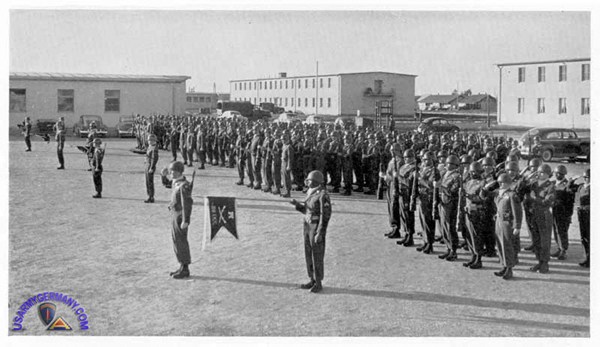
3rd Battalion review at Camp Roeder, 1952
|
|
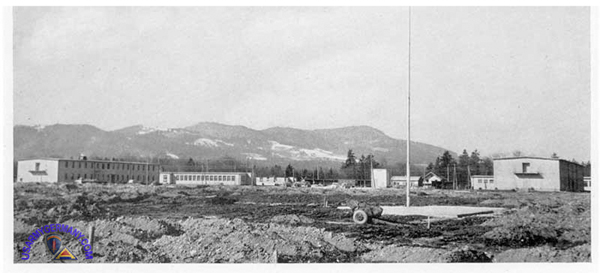
Camp Roeder parade field, 1952 |
|
| 1952 |
| (Source: Pictorial Review "350th Infantry , Austria 1952-1953") |
Reactivated at Camp Truscott, Salzburg, Austria, on June 1 1950 the 3rd Battalion consisted of Headquarters, "I" and "M" Companies. In September 1950 "K" Company was organized at Saalfelden, Austria, and moved to join the Battalion at Camp Truscott. During October 1950 the 3rd Battalion became full fledged fighting force with the activation of "L" Company.
Early in 1952 the Battalion moved to Camp Roeder, Austria, and started a strenuous training cycle with particular emphasis on field maneuvers, range firing and mountain warfare. |
|
|
| |
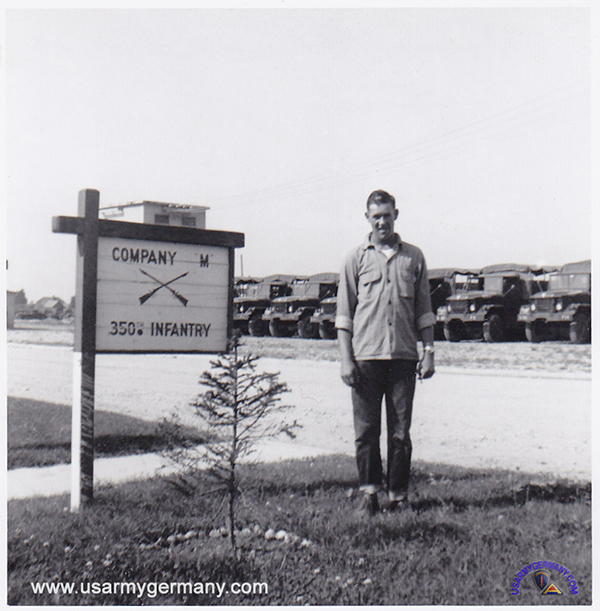
Basil Harris, Co M, 350th Inf Regt, Camp Roeder, 1953
|
| |
| 1953 |
| (Source: Email from Nancy Goodwin, daughter of Basil Harris, who served with Company M, 350th Infantry in Austria) |
| My father, Basil Harris, was in Company M 350th Infantry in 1953 (and I think into 1954) at Camp Roeder in Salzburg, Austria.
His papers show he entered active service January 9, 1953 and was discharged December 2, 1954. |
|
| |
| (Source: Email from Harold Badten) |
I was in Co. "I", 3rd Bn, (350th Inf Regt) from Nov. 1953 till Feb. 1955. I was a gunner of a 60mm mortar in the Weapons Platoon. One of my first things to do was to buy a good camera. I took several hundred colored slides during that time including ski school. Most of the photos on this Gallery Page were taken in 1954 as that was the the full year that I was there.
Being in Camp Roeder required a unique set of circumstances. Not just me but a group of men from Ft. Ord and the West Coast. I was drafted out of Waterville, Wa. 3/24/53. I was inducted at Ft. Lewis Wa. and sent to Ft. Ord and started basic training on my 20th birthday, 4/3/53. While in basic, I attempted to qualify for some kind of school if any to avoid being just combat infantry. No luck. I had a Class A profile and was told I was needed on the front lines in Korea. Period! I'm more lucky than good I guess because the Korean war ended a week or so before I finished my 16 weeks of basic. I asked again and they said I could now go to Leadership Training School. It's an 8 week advanced training school. When we graduated, they took all of us with last names starting with W, A, and B and made us squad leaders of a new concept called a "Buddy Company." These men were all from around southern Oregon I think and were inducted and trained and went over to Camp Roeder together. I don't know how they were placed but we were scattered throughout USFA. I can remember 4 of us in Company I and we hung out together a lot. We were all in the Weapons Platoon. It's better to be lucky than good!! What a nice tour of duty compared to front lines in Korea. |
|
| |
Co I, 350th Inf
Camp Roeder |
|
|
|
|
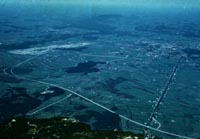
1. Camp Roeder (left) and Salzburg (right) (KB)
|
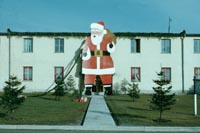
2. Barracks decorated for Christmas, 1954 (KB)
|
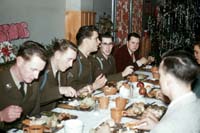
3. Christmas dinner for EM personnel (KB) |
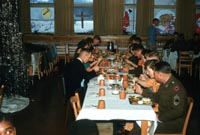
4. Christmas dinner for officers and NCOs (KB) |
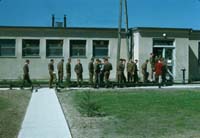
5. Pay day (KB) |
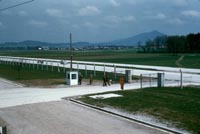
6. Gate closest to Co "I" (KB) |
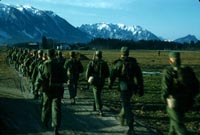
7. 20 mi road march (KB) |
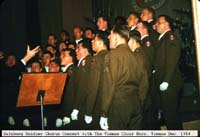
8. Salzburg Soldier Chorus with Vienna Boys Choir (KB) |
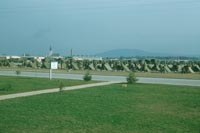
9. Full field inspection (KB) |
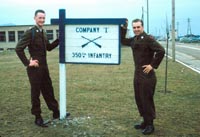
10. Company sign (KB) |
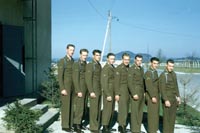
11. Good buddies (KB) |
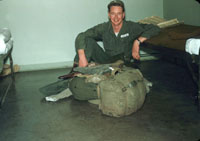
12. Going home (KB) |
| |
|
|
|
In the field
Saalfelden - Germany
|
|
|
|
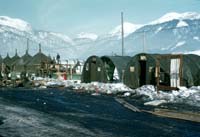
1. Ski school at Saalfelden (KB) |
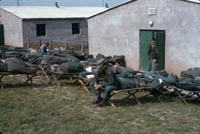
2. Maneuvers near Munich, Germany (KB) |
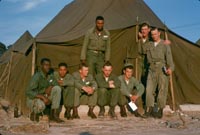
3. Maneuvers near Nürnberg (KB) |
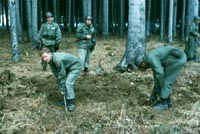
4. Digging fox holes near Camp Roeder (KB) |
| |
|
|
|
R&R
Berchtesgaden
|
|
|
|
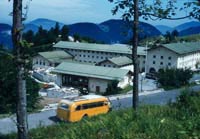
1. General Walker Hotel (KB) |
|
|
|
|
| |
Co I, 350th Inf
Camp Roeder |
|
Click on thumbnail for higher resolution image
|
|
|
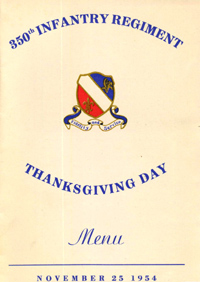
1. Cover (no higher resolution available)
|
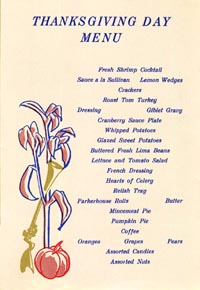
2. The menu for Thanksgiving Dinner (KB)
|
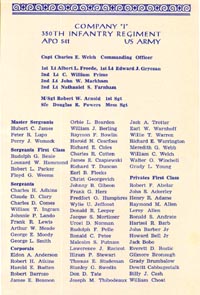
3. Page 1 of Roster (KB) |
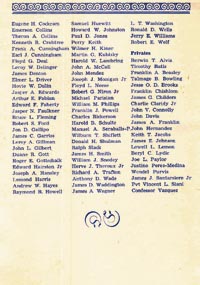
4. Page 2 of Roster (KB) |
|
 |
|
| |
Related Links:
|
| |
| |
|

